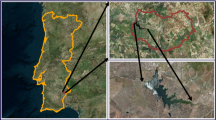Conclusions
-
1.
The results of using the model of an ideal mixer for calculating one of the integral hydrochemical indices of water quality — the annual BOD5 dynamics observed on reservoirs of the Zagorsk PSS in 1989 — permit concluding the correspondence of this mode to the on-site observation data.
-
2.
The methods of calculating the water self-purification coefficients developed on the basis of the model of an ideal mixer permit determining these coefficients by solving the inverse problem on the basis of the data of on-site observations of the actual water, hydrochemical, and hydrobiological regimes of an operating reservoir-analog (for conditions of a steady regime) and recalculating them theoretically for any given regime (steady and transient) of an operating or planned reservoir.
-
3.
An evaluation of the accuracy of various methods of calculating the self-purification coefficients and water quality in a reservoir (main and simplified) for the example of calculating the actual annual BOD5 dynamics of the Zagorsk PSS reservoirs during 1989 showed that they give results close among themselves and to the observed BOD5. This permits recommending both methods for practical use jointly or independently of one another.
Similar content being viewed by others

References
A. G. Sokolov, “Method of calculating and predicting the self-purifying capacity of reservoirs of the Zagorsk PSS,” Gidrotekh. Stroit., No. 9 (1992).
I. V. Gordin and A. G. Kocharyan, “Methods of estimating the self-purifying capacity of reservoirs,” Vodn. Res., No. 2 (9176).
Ya. F. Pleshkov, “Salt regimes of reservoirs (theory and engineering calculation),” Gidrokhim. Mat.,19 (1951).
A. P. Braslavskii, “Calculation of mineralization of water in reservoirs,” Gidrokhim. Mat.,32 (1961).
A. V. Karaushev, “External water exchange and formation of quality in lakes and reservoirs,” Tr. GTI, No. 249 (1978).
N. A. Davgyan and L. G. Aleksandrova, “Experimental investigations of external water exchange on a schematic model,” Tr. GTI, No. 249 (1978).
A. V. Karaushev, “Theoretical model of transport of wastewaters in lakes and reservoirs,” in: International Symposium on Specific Aspects of Hydrologic Calculations for Water-Management Planning [in Russian], Leningrad (1979).
V. F. Brekhovskikh, Hydrophysical Factors of the Formation of the Oxygen Regime in Water Bodies [in Russian], Nauka, Moscow (1988).
Additional information
Translated from Gidrotekhnicheskoe Stroitel'stvo, No. 4, pp. 48–52, April, 1996.
Rights and permissions
About this article
Cite this article
Sokolov, A.G. Use of a model of an ideal mixer for calculating hydrochemical water-quality indices of a reservoir. Hydrotechnical Construction 30, 222–228 (1996). https://doi.org/10.1007/BF02443081
Issue Date:
DOI: https://doi.org/10.1007/BF02443081


